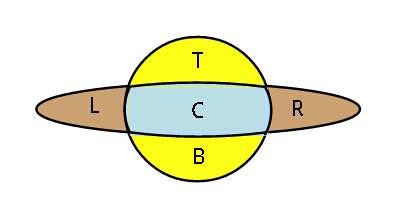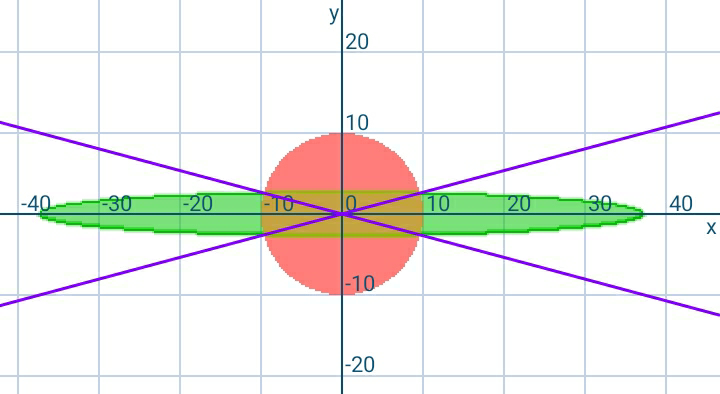Question Number 45313 by ajfour last updated on 11/Oct/18

Commented by ajfour last updated on 11/Oct/18

$${If}\:{all}\:{five}\:{areas}\:{are}\:{equal},\:{and} \\ $$$${circle}\:{has}\:{unit}\:{radius},\:{find} \\ $$$$\boldsymbol{{a}},{and}\:\boldsymbol{{b}}\:{of}\:{ellipse}. \\ $$
Answered by MrW3 last updated on 12/Oct/18

$${area}\:{of}\:{circle}={area}\:{of}\:{ellipse} \\ $$$${R}={radius}\:{of}\:{circle}=\mathrm{1} \\ $$$${area}\:{of}\:{each}\:{region}=\frac{\pi{R}^{\mathrm{2}} }{\mathrm{3}} \\ $$$${eqn}.\:{of}\:{circle}\:\left({polar}\:{system}\right): \\ $$$${r}={R} \\ $$$${eqn}.\:{of}\:{ellipse}\:\left({polar}\:{system}\right): \\ $$$$\frac{{r}^{\mathrm{2}} \mathrm{cos}^{\mathrm{2}} \:\theta}{{a}^{\mathrm{2}} }+\frac{{r}^{\mathrm{2}} \mathrm{sin}^{\mathrm{2}} \:\theta}{{b}^{\mathrm{2}} }=\mathrm{1} \\ $$$$\Rightarrow{r}^{\mathrm{2}} =\frac{{a}^{\mathrm{2}} {b}^{\mathrm{2}} }{{a}^{\mathrm{2}} \mathrm{sin}^{\mathrm{2}} \:\theta+{b}^{\mathrm{2}} \mathrm{cos}^{\mathrm{2}} \:\theta} \\ $$$$ \\ $$$${right}\:{top}\:{intersection}\:{point}\:{is}\:\left({r}_{\mathrm{1}} ,\theta_{\mathrm{1}} \right) \\ $$$${r}_{\mathrm{1}} ={R} \\ $$$$\frac{{a}^{\mathrm{2}} {b}^{\mathrm{2}} }{{a}^{\mathrm{2}} \mathrm{sin}^{\mathrm{2}} \:\theta_{\mathrm{1}} +{b}^{\mathrm{2}} \mathrm{cos}^{\mathrm{2}} \:\theta_{\mathrm{1}} }={R}^{\mathrm{2}} \\ $$$${a}^{\mathrm{2}} \mathrm{sin}^{\mathrm{2}} \:\theta_{\mathrm{1}} +{b}^{\mathrm{2}} \mathrm{cos}^{\mathrm{2}} \:\theta_{\mathrm{1}} =\left(\frac{{ab}}{{R}}\right)^{\mathrm{2}} \\ $$$${a}^{\mathrm{2}} \mathrm{sin}^{\mathrm{2}} \:\theta_{\mathrm{1}} +{b}^{\mathrm{2}} \left(\mathrm{1}−\mathrm{sin}^{\mathrm{2}} \:\theta_{\mathrm{1}} \right)=\left(\frac{{ab}}{{R}}\right)^{\mathrm{2}} \\ $$$$\Rightarrow\mathrm{sin}^{\mathrm{2}} \:\theta_{\mathrm{1}} =\frac{{b}^{\mathrm{2}} \left({a}^{\mathrm{2}} −{R}^{\mathrm{2}} \right)}{{R}^{\mathrm{2}} \left({a}^{\mathrm{2}} −{b}^{\mathrm{2}} \right)} \\ $$$$\Rightarrow\mathrm{cos}^{\mathrm{2}} \:\theta_{\mathrm{1}} =\mathrm{1}−\frac{{b}^{\mathrm{2}} \left({a}^{\mathrm{2}} −{R}^{\mathrm{2}} \right)}{{R}^{\mathrm{2}} \left({a}^{\mathrm{2}} −{b}^{\mathrm{2}} \right)}=\frac{{a}^{\mathrm{2}} \left({R}^{\mathrm{2}} −{b}^{\mathrm{2}} \right)}{{R}^{\mathrm{2}} \left({a}^{\mathrm{2}} −{b}^{\mathrm{2}} \right)} \\ $$$$\Rightarrow\mathrm{tan}\:\theta_{\mathrm{1}} =\frac{{b}}{{a}}\sqrt{\frac{{a}^{\mathrm{2}} −{R}^{\mathrm{2}} }{{R}^{\mathrm{2}} −{b}^{\mathrm{2}} }} \\ $$$$\Rightarrow\theta_{\mathrm{1}} =\mathrm{tan}^{−\mathrm{1}} \left(\frac{{b}}{{a}}\sqrt{\frac{{a}^{\mathrm{2}} −{R}^{\mathrm{2}} }{{R}^{\mathrm{2}} −{b}^{\mathrm{2}} }}\right) \\ $$$$ \\ $$$${area}\:{of}\:{rightmost}\:{region}\:{is} \\ $$$${A}_{{R}} =\mathrm{2}\int_{\mathrm{0}} ^{\theta_{\mathrm{1}} } \frac{\mathrm{1}}{\mathrm{2}}\left({r}^{\mathrm{2}} −{R}^{\mathrm{2}} \right){d}\theta \\ $$$$=\int_{\mathrm{0}} ^{\theta_{\mathrm{1}} } \left(\frac{{a}^{\mathrm{2}} {b}^{\mathrm{2}} }{{a}^{\mathrm{2}} \mathrm{sin}^{\mathrm{2}} \:\theta+{b}^{\mathrm{2}} \mathrm{cos}^{\mathrm{2}} \:\theta}−{R}^{\mathrm{2}} \right){d}\theta \\ $$$$={a}^{\mathrm{2}} {b}^{\mathrm{2}} \int_{\mathrm{0}} ^{\theta_{\mathrm{1}} } \frac{{d}\theta}{\left({a}\:\mathrm{sin}\:\theta\right)^{\mathrm{2}} +\left({b}\:\mathrm{cos}\:\theta\right)^{\mathrm{2}} }−{R}^{\mathrm{2}} \theta_{\mathrm{1}} \\ $$$$={ab}\:\mathrm{tan}^{−\mathrm{1}} \left(\frac{{a}\:\mathrm{tan}\:\theta_{\mathrm{1}} }{{b}}\right)−{R}^{\mathrm{2}} \theta_{\mathrm{1}} \\ $$$$={ab}\:\mathrm{tan}^{−\mathrm{1}} \left(\sqrt{\frac{{a}^{\mathrm{2}} −{R}^{\mathrm{2}} }{{R}^{\mathrm{2}} −{b}^{\mathrm{2}} }}\right)−{R}^{\mathrm{2}} \mathrm{tan}^{−\mathrm{1}} \left(\frac{{b}}{{a}}\sqrt{\frac{{a}^{\mathrm{2}} −{R}^{\mathrm{2}} }{{R}^{\mathrm{2}} −{b}^{\mathrm{2}} }}\right)=\frac{\pi{R}^{\mathrm{2}} }{\mathrm{3}} \\ $$$$ \\ $$$${let}\:\lambda=\frac{{a}}{{R}}\Rightarrow{a}=\lambda{R} \\ $$$${since}\:\pi{ab}=\pi{R}^{\mathrm{2}} \Rightarrow{ab}={R}^{\mathrm{2}} \Rightarrow{b}=\frac{{R}^{\mathrm{2}} }{{a}}=\frac{{R}}{\lambda} \\ $$$$\Rightarrow\mathrm{tan}^{−\mathrm{1}} \lambda−\mathrm{tan}^{−\mathrm{1}} \frac{\mathrm{1}}{\lambda}=\frac{\pi}{\mathrm{3}} \\ $$$$\Rightarrow\mathrm{tan}^{−\mathrm{1}} \lambda−\left(\frac{\pi}{\mathrm{2}}−\mathrm{tan}^{−\mathrm{1}} \lambda\right)=\frac{\pi}{\mathrm{3}} \\ $$$$\Rightarrow\mathrm{tan}^{−\mathrm{1}} \lambda=\frac{\mathrm{5}\pi}{\mathrm{6}} \\ $$$$\Rightarrow\lambda=\mathrm{tan}\:\frac{\mathrm{5}\pi}{\mathrm{6}}=\mathrm{2}+\sqrt{\mathrm{3}} \\ $$$$\Rightarrow{a}=\left(\mathrm{2}+\sqrt{\mathrm{3}}\right){R} \\ $$$$\Rightarrow{b}=\frac{{R}}{\mathrm{2}+\sqrt{\mathrm{3}}}=\left(\mathrm{2}−\sqrt{\mathrm{3}}\right){R} \\ $$$$\Rightarrow\theta_{\mathrm{1}} =\mathrm{tan}^{−\mathrm{1}} \left(\frac{\mathrm{1}}{\lambda}\right)=\mathrm{tan}^{−\mathrm{1}} \left(\mathrm{2}−\sqrt{\mathrm{3}}\right)=\mathrm{15}° \\ $$
Commented by MrW3 last updated on 12/Oct/18

Commented by ajfour last updated on 12/Oct/18

$${Great}\:;\:{thank}\:{you}\:{very}\:{much}\:{Sir}. \\ $$
Commented by behi83417@gmail.com last updated on 12/Oct/18

$${nice}\:{problem}\:{and}\:{beautiful}\:{solution}. \\ $$$${thanks}\:{a}\:{lot}\:{sir}\:{Ajfour\&}\:{sir}\:{mrW}\mathrm{3}. \\ $$$$ \\ $$
Commented by ajfour last updated on 12/Oct/18

$${can}\:{we}\:{now}\:{have}\:{a}\:{question}\:{from} \\ $$$${you},\:{behi}\:{Sir}. \\ $$
Commented by behi83417@gmail.com last updated on 12/Oct/18

$${ofcource}\:{sir}\:{Ajfour}.{Q}#\mathrm{45366}\:{lunched} \\ $$$${and}\:{waiting}\:{for}\:{your}\:{attention}. \\ $$
